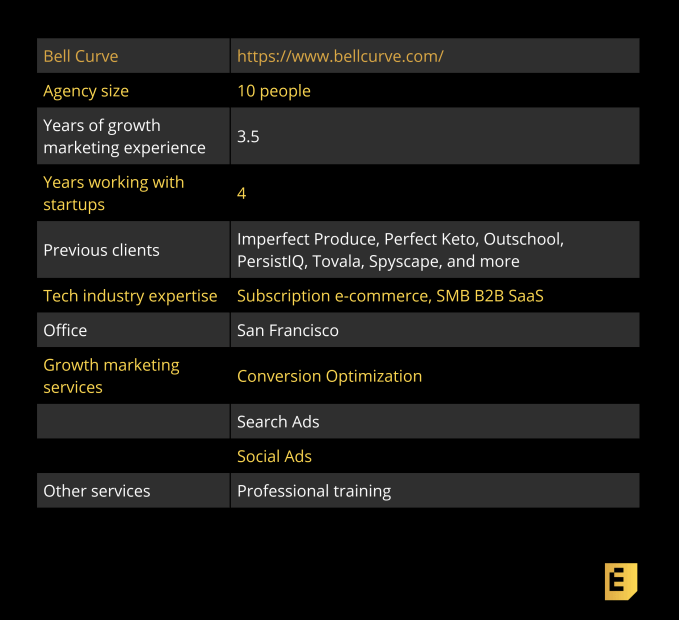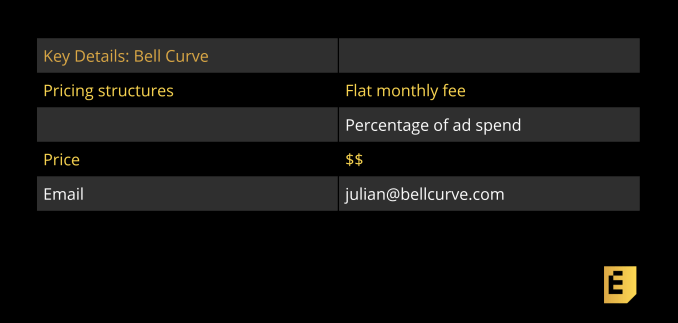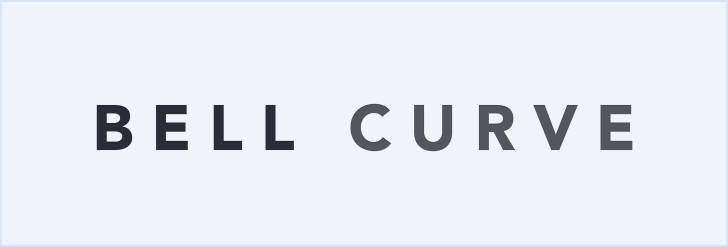Bell Curve founder Julian Shapiro describes his team as talented growth marketers who have a long tail expertise of various channels and who aren’t afraid to play part-time therapists. As an agency, they’re comfortable grounding founder expectations by explaining “No, virality isn’t a dependable growth strategy,” but “Hey, we can come up with a better strategy together.”
Bell Curve, the agency, also runs Demand Curve, a remote growth marketing training program that teaches students (and marketing professionals) the ins and outs of performance marketing.
For a glimpse of how Bell Curve thinks about growth marketing, check out Julian’s guest posts about how startups can actually get content marketing to work and how founders can hire a great growth marketer.
What makes Bell Curve different:
“Bell Curve runs a growth bootcamp which we took in February. It radically improved our growth rate, gave us access to enough data to experiment with, and as a result we built an engine for growth that we could continue to tune.” Gil Akos, SF, CEO & Co-founder, Astra
In effect, companies come to us when they need expertise beyond Facebook, Google and Instagram, which we still bring to the table, but when they also need to figure out how to make Quora ads profitable, how to get Reddit working, how to get YouTube videos working, Snapchat, Pinterest, etc. These are channels people don’t specialize in enough and so we also bring that long tail of expertise.”
On common misconceptions about growth:
“A common mistake people make coming into growth is thinking that growth hacks are a meaningful thing. The ultimate growth hack is having the self-discipline to pursue growth fundamentals properly and completely. So, things like properly A/B testing, identifying your most enticing value propositions and articulating them clearly and concisely, bringing in deep channel expertise for Facebook, Instagram, Google Search, and a couple of other channels. These are the tenants of making digital growth work. Not one-off hacks.”

Below, you’ll find the rest of the founder reviews, the full interview, and more details like pricing and fee structures. This profile is part of our ongoing series covering startup growth marketing agencies with whom founders love to work, based on this survey and our own research. The survey is open indefinitely, so please fill it out if you haven’t already.
Interview with Bell Curve Founder Julian Shapiro

Yvonne Leow: Can you tell me a little bit about how you got into this game of growth?
Julian Shapiro: I actually started by running growth for friends’ companies because they had a hard time finding experienced growth marketers. After a year and a half of doing this, I realized it’d be a more stable source of income if I formed an agency. It’d also allow me to pattern match so I could exchange learnings among clients and have a better net performance.
It all came together very quickly. Once Bell Curve hit about 10 clients, we had enough strategic and customer acquisition overlap that we were able to share tactics, double our volume of A/B testing, and get better results. It also gave us the ability to hire out a full-fledged team so we could start specializing, whereas, as a contractor, I was too much of a generalist. I wasn’t able to go deep on certain channels, like Snapchat or Pinterest ads.
Yvonne Leow: Awesome. What were some of the learnings you had working with founders, and how did that translate that into the creation of Bell Curve?
Julian Shapiro: Our key learnings were:
- If you go very deep with your expertise on just a few things, you can forsake a lot of other things and still get a lot of growth in a short amount of time. So, for example, Facebook ads, Instagram ads, conversion rate optimization, which is where you optimize pages to prompt people to purchase or sign up at a higher rate. Those three things out of say 100 things you could be doing for growth are so high leverage that if I afforded my team the opportunity to specialize in those three categories, we would probably see the greatest rate of success per client.
- From a client management standpoint, it took us a while to understand what a healthy relationship looks like between a client and an agency. We started by offering a broad range of services, and we incrementally narrowed it until we identified the three things that we could scope in such a way so that the workload was consistent and we could hit aggressive deadlines. Actually getting good at growth was a very quick journey. The longer journey was understanding how to keep clients happy.

Yvonne Leow: Right. What is Bell Curve’s growth philosophy?
Julian Shapiro: Our philosophy is to set realistic expectations. I’ll give you an example: Most clients come to us thinking that if they have $50,000 a month in ad spend that it’s just a matter of signing an agency that can double, triple, quadruple that, and that they’ll have a similar increase in revenue and their business will be off to the races.
In reality, for the majority of companies, there’s a limited amount of growth you can get from Facebook before it tops out. We often have to set expectations with clients very early and say to them “Listen, you already have Facebook working near its maximum capacity so if you want to get more performance out of your paid acquisition, or any other aspect in growth marketing, that performance will likely have to come from elsewhere, like conversion rate optimization.
If you are coming to us with the expectation that we can quadruple your Facebook spend while retaining your profitability on Facebook, then it’s likely not going to happen.” So we often play the role of a therapist and reality checker by walking them through all the other channels they could focus on.
A large part of our job is helping clients understand because once they get an initial taste of Facebook success, for example, they think they can grow in an unlimited fashion. What we’ll do instead is say, “Hey listen, your landing page is other parts of your website are under-optimized.
Those are actually the bottlenecks preventing Facebook from growing further.” Or, one last example. “You guys are really focusing on Facebook, but you’re going to have to complement the number of customers Facebook is driving you with additional channels, such as Snapchat, Google Search, Google Shopping, YouTube video, and so forth.”
Yvonne Leow: Does Bell Curve have a particular expertise when it comes to a platform or industry?
Julian Shapiro: We run a program where we train companies and founders to run ads on every channel so what makes Bell Curve unique is that we have a deep understanding on many more channels than the average agency. We have an archive of tactics and approaches that we’ve accumulated for how to do those just as well.
In effect, companies come to us when they need expertise beyond Facebook, Google and Instagram, which we still bring to the table, but when they need to figure out how to get Quora ads working, how to get Reddit working, how to get YouTube videos working, Snapchat, Pinterest, etc. These are channels people don’t specialize in enough and so we bring that long tail of expertise.
Yvonne Leow: When it comes to the clients you decide to take on, what’s the decision-making process like? What kind of company would be a good fit for Bell Curve?
Julian Shapiro: We identify a good fit using two criteria. One, do they pattern match onto past clients that commonly succeed? We’ll frequently see subscription e-commerce businesses that are selling products towards consumers. That is the type of business that most frequently succeeds so you get scored higher in our assessment if that’s your business model.
Secondly, what are your expectations? Do you have external pressures from investors who want you to quadruple your Facebook ads budget in the next month? If so, we audit your Facebook ads account and assess whether that’s realistic. We may push back or decide not to work with you.
Yvonne Leow: Say I’m a founder and we’ve decided to work together. What are your next steps?
Julian Shapiro: We deliver on a very short turnaround time so that we can get ads running. We make sure your conversion tracking is properly set up and that you have ad reporting in place. We make sure there are no major bottlenecks on your homepage or other landing pages that we send ad traffic to.
We also identify your value propositions as a business, the aspects that make it appealing to others. We then flip on a few ad channels to start. We gradually rule out channels that we’re testing and start trying new channels.
Our goal is to thoroughly vet the client’s viability across all major channels, but we’ll start with just those we think will get them to scale and profitability the quickest.
Yvonne Leow: Does Bell Curve work with a lot of early-stage companies?
Julian Shapiro: Yes, we don’t discriminate based on what stage companies are in, however, we do discriminate based on whether they have already shown ads to work to some extent.
So if you’re early stage and your ads are working, and you’re showing profitability, and you hit all the other criteria we have, like audience size, profit, margin and so forth, then your stage is irrelevant to us. If we look at the clientele Bell Curve has had over the last two and a half years, certainly a majority have been somewhere between seed and series A.
Yvonne Leow: Got it. How long is each Bell Curve engagement? What’s the timeline?
Julian Shapiro: Unlike other agencies, we don’t bind clients in minimum contract lengths because we have a good enough retention rate that we haven’t found a need to lock anyone into an engagement. We have clients who range from between an average of probably five months to two years.
Those who skew more toward the five-month mark are those that switch to an in-house marketer, or perhaps we simply couldn’t get anything working with whatever their target metrics were. This is increasingly rare because we’re getting better at screening out clients that we know we won’t be able to do a good job for.
Yvonne Leow: Do you have an example of some of those businesses that usually don’t work out?
Julian Shapiro: Yeah, if you have very low margins, a low price point, a limited audience, and if your product is not a must have, then all of that criteria work against you. In contrast, products that typically perform well are products that people are already buying, like a mattress or a T-shirt.
If you come to them at the right time in their life when they’re looking to buy one of those things then they’ll very well consider you. That hits the need criterion. Mattress companies like Casper, for example, have exploded through paid advertising.
Since their price point is so high, their margin is also high. They can afford the customer acquisition cost of Facebook and Instagram. That hits the price point criterion. In terms of audience size, people have to sleep on something so a mattress will need to be purchased at some point.
That hits the audience size criterion. When all of those criteria come together it becomes a no-brainer engagement.
Those are the companies we lean into the most, but we’re also up for a challenge if we’re passionate about the client’s potential. Generally, if we don’t foresee potential, we’re honest with the client and we won’t waste their time or money.
Yvonne Leow: Related to that, what is your pricing structure?
Julian Shapiro: Our pricing is standard. We charge a flat monthly fee, and then if we spend more than a certain amount on ads for you in a month, we will take a small percentage of that amount over a threshold. That threshold varies based on what a client’s current rates of spend are.
So we try to set a threshold that is fair to them by giving them a target to reach that is above their current performance levels. And if they don’t really have ads working that well to begin well, then we’ll use a default threshold, which is really determined by what we think is reasonable to hit with the target metrics the company is coming to us with.
Yvonne Leow: What motivated Bell Curve to create the training program Demand Curve?
Julian Shapiro: The training program came about from the number one request we get for something we do not offer, which is introductions to growth marketers people can hire. So after a while we thought, “We don’t even know where to get growth marketers, so how about we just train companies to do what we do?”
The first hypothesis to validate was whether we could actually convey the low-level tactics and high-level theory that we use day to day in the span of just a month. It took about half a year to develop a curriculum and a set of teaching practices that combine deliberate practice, live screen shares, and mentorship. So it’s actually a four-pronged approach to getting the advice and the material to stick.
Once we proved we could effectively teach people how to do what we do, we then branched out to offer training services, namely for founders and marketers at seed stage startups that need in-house growth talent and are unable to find a growth marketer or perhaps can’t afford to hire one yet. The service was effective enough that it prompted us to also begin offering career training.
Historically, you could only come to us as a training student if you were a company, but now you can come to us as an individual and we’ll put you through a doubly intensive training program that lasts a little over twice as long and requires more daily hours spent, and at the end of this program, we’ll help you get hired. We won’t charge you anything up front, and we’ll just take a small percentage of your salary.
Yvonne Leow: Very cool. Do you think this is representative of a broader trend in tech?
Julian Shapiro: We do. Generally speaking, a lot of the higher paying tech jobs may not need to be trained in person or by a university, and can be trained in a more limited time frame, like two to nine months. Online training programs for roles like programming, marketing, data science, maybe even sales, are viable ways to get professional expertise instilled in aspiring tech workers. The kicker is you remove the financial risk for the students and place it on the instructors. That is the only way you can properly align educational incentives so that the school or program actually cares about teaching effectively for the real world.
Yvonne Leow: What do you see are common mistakes founders might make when it comes to growth?
Julian Shapiro: A common mistake people make coming into growth is thinking that growth hacks are a meaningful thing. The ultimate growth hack is having the self-discipline to pursue growth fundamentals properly and completely.
So things like properly A/B testing, identifying your most enticing value propositions and articulating them clearly and concisely, bringing in deep channel expertise of Facebook, Instagram, Google search, and a couple of other channels. These are the tenants of making digital growth work.
Not one-off hacks. Growth hacks, like exploiting loopholes in other platforms, those work as anomalies, not as de facto ways to grow a business. Most people don’t want to hear this because they want shortcuts, but to become a growth marketer, you have to have an appreciation for the discipline and the rigor involved in being data-driven, methodical, and almost OCD around perfecting the core tenants of growth marketing.
Yvonne Leow: Got it. How critical is understanding consumer behavior in understanding growth marketing?
Julian Shapiro: It’s funny because you can be somewhat blind to Internet culture, and still perform very well in growth marketing if your rigorous in A/B testing your value propositions and the way you frame those value propositions.
If you drop an alien on planet Earth and say, “Here’s a $100,000 to spend on Facebook,” and they had the discipline to act on those growth fundamentals I mentioned, like A/B testing, value, profit, and education, and therefore they tested 100 different ways to pitch a particular product.
That data-driven approach to identifying what consumers want will likely get you to what they want the same way as having been a consumer research expert who intimately understands the needs of everyone.
Founder Recommendations:
“Bell Curve runs a growth bootcamp which we took in February. It radically improved our growth rate, gave us access to enough data to experiment with, and as a result we built an engine for growth that we could continue to tune.” – Gil Akos, SF, CEO & Co-founder, Astra
“Bell Curve has a comprehensive growth training program, leading students from creating a growth plan, tracking data, acquiring users, and converting them.” – Huey Kwik, SF, Director of Growth, Mystery Science
“Massive success in underutilized channels and strategic vision, can’t recommend highly enough.” – Jeremy Gurewitz, SF, Head of Growth, Imperfect Produce
“Bell Curve went above and beyond what was expected of them during our time working with them. We’ve worked with many third-party firms over the past 4 years but Bell Curve is the only one we plan on working with again. They are incredible planners and executors. They clearly communicate with all the team and promptly report their KPIs. They have made growth a science.” – Nick Wright, London, UK, CEO & Founder, Midnite
